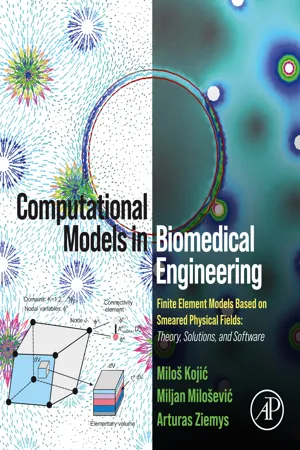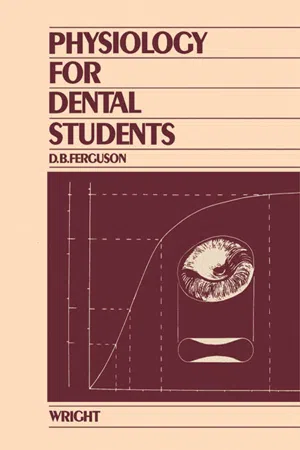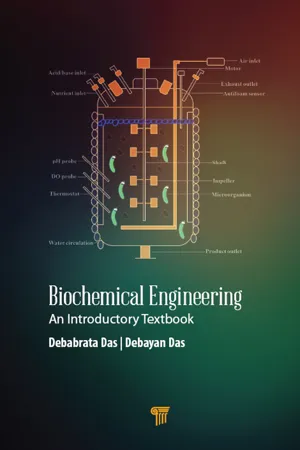Biological Sciences
Mass Transport in Animals
Mass transport in animals refers to the movement of substances such as oxygen, nutrients, and waste products throughout the body. This process is essential for maintaining homeostasis and providing cells with the necessary resources for survival. In animals, mass transport occurs through mechanisms such as the circulatory system, which utilizes the heart to pump blood and the blood vessels to distribute substances to various tissues and organs.
Written by Perlego with AI-assistance
Related key terms
3 Key excerpts on "Mass Transport in Animals"
- eBook - ePub
Computational Models in Biomedical Engineering
Finite Element Models Based on Smeared Physical Fields: Theory, Solutions, and Software
- Milos Kojic, Miljan Milosevic, Arturas Ziemys(Authors)
- 2022(Publication Date)
- Academic Press(Publisher)
1: Basic processes in living organisms
Abstract
A brief overview of the basic processes in living organisms is presented in this introductory chapter. The goal is to provide the reader with information about fundamental physiological processes, which are modeled by computational methods in subsequent chapters. The text gives an insight into the complexity of biological systems and background for understanding the approximations used further in the mathematical interpretations and generation of numerical results. Mass transport is first described, as the vital process mostly governed by diffusion and then is given basic information about the transport of matter within the circulatory system, tissue, and cells. Finally, the role of the heart, lung, liver, and brain as body organs is outlined, with reference to specificities of the tissue microenvironment of these organs.Keywords
Body organs; Cells; Circulatory system; Diffusion; Mass transport; Microenvironment; Tissue1.1. Introduction: mass transport as a vital process in living organisms
The life of biological organisms is fundamentally associated with growth, motion, multiplication, evolution, interactions with their environment and other living organisms. All these biological fundamental events to occur need energy. Usually, the energy in living systems is accumulated and used in chemical and electrochemical forms. To maintain the integrity of living systems and the energy balance, biological organisms need to absorb the energy of physical or chemical nature through complex processes of mass transfer and conversion. Thus, mass transfer (or mass transport) is one of the fundamental manifestations of living organisms that enable all their functions. Would it be the slow movement of a single cell organism ameba on the surface of the water in a lake or humans undergoing strenuous exercises in the Olympic Games, the mass transfer phenomena are present all the time. Even in the event of death, living organisms decay, and their accumulated mass is transformed and may dissipate into the environment according to the same principles of mass transfer that sustained life before. The mass transfer phenomena involved in living organisms may be described and understood by universal laws of physics connecting mass transfer efficiency with properties of transported matter itself and boundary conditions of a particular system. - eBook - ePub
- D. B. Ferguson(Author)
- 2014(Publication Date)
- Butterworth-Heinemann(Publisher)
Transport of materials has so far been considered as local movement of water and solutes. The body can also move gases or fluids, together with suspended particles, along defined internal pathways. The two principal pathways are those of the respiratory system, made up of the nasopharynx, the trachea, the bronchi, the bronchioles and the alveolar sacs; and the circulatory system, made up of the heart, the aorta, the arteries, the arterioles, the metarterioles, the capillaries, the venules, and the veins. Transport in the respiratory system is tidal, with air or gases being moved in and out rhythmically; in the circulatory system a pump drives a fluid round two enclosed circuits in sequence. Other bulk transport systems include the digestive tract, a tube whose lumen is actually external to the body, which carries a semi-fluid mass from mouth to anus, the ureters which transport urine from the kidney to the bladder, and the lymphatic system which carries lymph from the tissue fluid to the thoracic duct and then the subclavian vein.The physical rules governing flow in any system apply to bulk flow of fluids (liquids or gases) in the body: flow takes place down gradients of pressure, and its rate is affected by the size and resistance of the flow channels.The driving force
Fluids flow only when there is a net pressure difference between two points. Flow of blood depends upon contraction of heart muscle to produce pressure within the ventricular chambers. From there to the re-entry of the great veins or the pulmonary veins to the heart there is a steady fall in pressure of some 16 kPa in the systemic circuit and some 3.3 kPa in the lung circuit. The flow is maintained by the heart valves which prevent backflow and maintain a unidirectional pressure gradient.In the thoracic cavity, expansion of the enclosed volume by depression of the diaphragm (effectively acting as a piston) and by the raising of the ribs to increase the outer radius, reduces the gas pressure in the lungs below atmospheric and allows air to flow in. Recoil of the piston and the walls similarly raises the intrapulmonary pressure and air flows out to the atmosphere down a pressure gradient.Laminar and turbulent flow
When a fluid passes along a smooth-walled tube, the layers of fluid in contact with the walls experience drag due to friction. The extent of such frictional drag depends upon the roughness of the wall surface. A fluid moving at low velocity, therefore, travels most rapidly in the centre of the tube, and its velocity decreases smoothly to a minimum along the walls where it is subject to frictional drag (Fig. 6.1 - eBook - ePub
Biochemical Engineering
An Introductory Textbook
- Debabrata Das, Debayan Das, Debabrata Das, Debayan Das(Authors)
- 2019(Publication Date)
- Jenny Stanford Publishing(Publisher)
Chapter 9Transport Phenomena of Bioprocesses
Transport phenomena is the study of the movement of different physical quantities in any chemical or biochemical process and consists of the basic principles and laws of transport. It also describes the relations and similarities among different types of transport that may occur in any system. A proper knowledge of transport phenomenon is necessary in order to effectively design and efficiently operate a bioprocess/biochemical plant. The current chapter lists the fundamentals of transport processes that one comes across in the bioprocessing industries. Hence, this topic is important for people from the chemical as well as non-chemical backgrounds. The word “transport phenomenon” in chemical engineering encompasses the subjects of momentum transfer or fluid mechanics, mass and energy, or heat transfer processes:• Momentum transport deals with the transport of momentum in fluids and is also known as fluid dynamics, e.g., blood circulation in body, mixing phenomena in bioreactor.• Energy or heat transport deals with the transport of different forms of energy in a system and is also known as heat transfer, e.g., sterilization of reactor, temperature control in bioreactor.• Mass transport deals with the transport of various chemical species themselves and is also known as mass transfer, e.g., oxygen transport from bubbles to aerobic microorganism.At the beginning, the important and fundamental topics of fluid mechanics will be covered, followed by the heat transfer principles and mass-transfer phenomenon. A typical example of fluid mechanics may be the flow of various fluids in conduit and pipes in the biochemical industry. Note that such flows result in significant pressure drop due to friction, and the mathematical expression of such situations is incorporated in the subject of fluid mechanics. Similarly, the cooling or heating of fluids in a fermenter involves the transfer of heat from the system to the fluid within the fermenter or vice versa. Such cases are typical examples of the phenomenon of heat transfer in biochemical industries. An example of mass-transfer process in biochemical process plants or industries is that of the oxygen transport to the media broth (culture) from the atmosphere (air) within the aerobic fermenter. Three different types of physical quantities are used in transport phenomena: scalar (e.g., temperature, pressure, and concentration), vector (e.g., velocity, momentum, and force), and second-order tensor (e.g., stress or momentum flux and velocity gradient).
Learn about this page
Index pages curate the most relevant extracts from our library of academic textbooks. They’ve been created using an in-house natural language model (NLM), each adding context and meaning to key research topics.


